Loose Bits
© Frank Ford, 7/4/00; Photos by FF, 2000
"My guitar buzzes when I play it."
"Maybe it has bees," I replied
Every so often I'd use that line to a customer when it seemed like everyone was ready for a little chuckle. Eventually I did see a guitar that buzzed because of bees -- well, mud dauber wasps, really. The wasps had started building a nest inside near the bridge and the dried mud was loose and rattling. Of course that day I hadn't told my little bee joke, so once again, I didn't get credit for extreme wisdom.
Your entire guitar vibrates when you play it. The top most of all, but even the neck and peghead are moved by the vibrating string's energy. Any loose part anywhere on the guitar may buzz or rattle audibly, some times sympathetically only when certain notes are played. Parts don't have to be visibly loose to rattle and it can be quite a job to chase down the causes of some of these little noises.
Often a loose, rattling part can be located by "rapping" with your knuckle on the instrument in various places. If you knock on the body, and the noise appears to come from the neck, then there's probably something loose at the neck or peghead. If the noise occurs only when you rap on the back, then there's probably a brace loose inside there, and so on. If you're trying to track down a mystery buzz, don't forget to check out the Buzz Diagnosis Pages.
Let's take a look a some of the parts of an acoustic guitar that may speak for themselves if they become loose. Clearly, most other fretted instruments have analogous parts and problems, so most of these considerations will apply to mandolins, banjos, etc.
The headstock is an obvious place to start because there are always things screwed on there. Most all the parts of the tuners have the potential for looseness and rattling. The nuts that screw down from the top have thin washers under them to protect the face of the headstock. They are screwed tight when the guitar is first assembled, but may become loose because the wood compresses a bit. After the guitar is a few months old it's a good idea to tighten these nuts a bit. Rattling washers are among the most common loose items on a guitar headstock.

These press-fit bushings can ride up and rattle:

Tuner buttons become loose for a variety of reasons. Sometimes the little retaining screws just back themselves out a little, and the button starts to rattle sympathetically at certain frequencies:
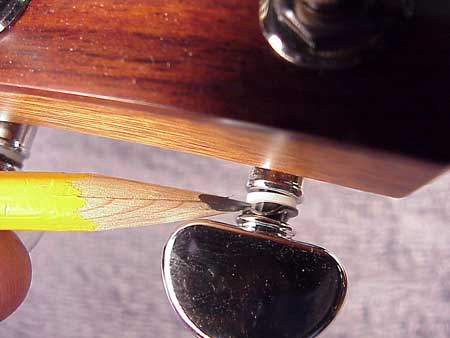
Simply tightening the screw will fix this one nicely.
Here, I'm dropping a tiny bit of very thin acrylic glue onto the button shaft to secure the little decorative collar. It is almost imperceptibly loose, but it makes a nasty noise when the instrument is played:

Truss rod covers don't have to be damaged as this one in order to be loose enough to rattle:

Rattling, loose truss rod covers are not common, but they certainly are annoying.
Underneath the cover, though, the truss rod nut may be loose, and it or the washer under it may make a lot of noise:
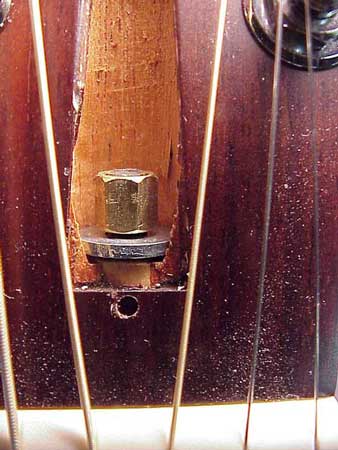
Even if no tension is needed on the truss rod it's generally a good idea to tighten the truss rod nut just enough to keep it from coming unscrewed and allowing the washer to become loose.
Still concentrating on the peghead, we can hear a special kind of string buzz if a string passes too close to a tuning post:
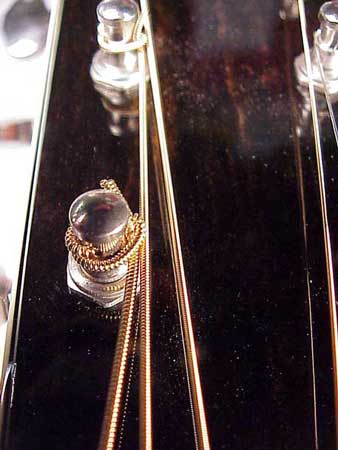
Here the string is held at just the right distance to cause it to buzz with a peculiar "fuzzy" note. You can avoid this rattle by noticing how the string touches its neighbor when you restring the guitar. If the design of the peghead won't allow enough clearance, then make sure the string rubs tightly against the post by adding a few extra turns around the offending post. The string should either miss the post altogether, or it should be held against the post tightly enough so it doesn't rattle. It may sound tricky, but it is very easy to keep this problem under control as you restring the guitar.
The free end of the string should be cut short so it doesn't dangle around and rattle or buzz:
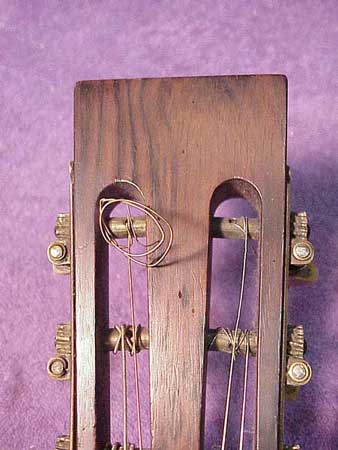
A clumped up mass of extra string at the peghead may have a casual or folksy look, but it can be a source of nasty noises.
The strings themselves can have loose windings, particularly when they become very old and worn:

A string with severed windings like these will make just about the worst, deadest, buzzing noise you can get from an acoustic guitar!
Inside its neck, the steel string guitar usually has an adjustable truss rod:
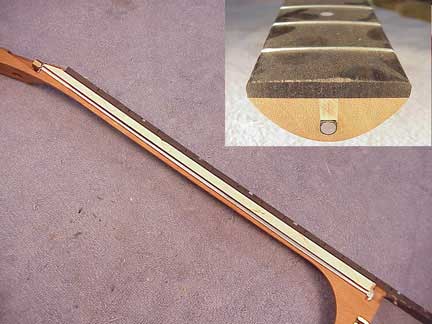
Even if this rod is a bit loose, it generally doesn't rattle when the guitar is played. But sometimes, a truss rod may be either loose or tight, and may just graze the inside wall of the slot into which it is installed. Play just the right note, and the truss rod sings out loudly from inside the neck as it vibrates sympathetically. If you change the adjustment of the rod just a hair, you might keep it from rattling. The conventional repair for a rattling truss rod is to inject a bit of glue through a tiny hole drilled through the fingerboard down into the cavity that houses the truss rod. In skilled hands, this is a very safe procedure
More